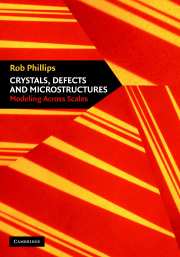Book contents
- Frontmatter
- Contents
- Preface
- Acknowledgements
- Notes on Units, Scales and Conventions
- Part One Thinking About the Material World
- Part two Energetics of Crystalline Solids
- 4 Energetic Description of Cohesion in Solids
- 5 Thermal and Elastic Properties of Crystals
- 6 Structural Energies and Phase Diagrams
- Part three Geometric Structures in Solids: Defects and Microstructures
- Part four Facing the Multiscale Challenge of Real Material Behavior
- References
- Index
6 - Structural Energies and Phase Diagrams
Published online by Cambridge University Press: 29 October 2009
- Frontmatter
- Contents
- Preface
- Acknowledgements
- Notes on Units, Scales and Conventions
- Part One Thinking About the Material World
- Part two Energetics of Crystalline Solids
- 4 Energetic Description of Cohesion in Solids
- 5 Thermal and Elastic Properties of Crystals
- 6 Structural Energies and Phase Diagrams
- Part three Geometric Structures in Solids: Defects and Microstructures
- Part four Facing the Multiscale Challenge of Real Material Behavior
- References
- Index
Summary
Structures in Solids
A central tenet of materials science is the intimate relation between structure and properties, an idea that has been elevated to what one might call the structure–properties paradigm. However, we must proceed with caution, even on this seemingly innocent point, since materials exhibit geometrical structures on many different scales. As a result, when making reference to the connection between structure and properties, we must askourselv es: structure at what scale? This chapter is the first in a long series that will culminate in a discussion of microstructure, in which we will confront the various geometric structures found in solids. The bottom rung in the ladder of structures that make up this hierarchy is that of the atomic-scale geometry of the perfect crystal. It is geometry at this scale that concerns us in the present chapter.
In crystalline solids, the atomic-scale geometry is tied to the regular arrangements of atoms and is described in terms of the Bravais lattice. At this scale, the modeling of structure refers to our ability to appropriately decipher the phase diagram of a particular material. What is the equilibrium crystal structure? What happens to the stable phase as a function of an applied stress, changes in temperature or changes in composition? And a more subtle question, what are the favored metastable arrangements that can be reached by the system? At the next level of description, there are a host of issues related still to the atomic-level geometry, but now as concerns the various defects that disturb the perfect crystal.
- Type
- Chapter
- Information
- Crystals, Defects and MicrostructuresModeling Across Scales, pp. 253 - 308Publisher: Cambridge University PressPrint publication year: 2001

